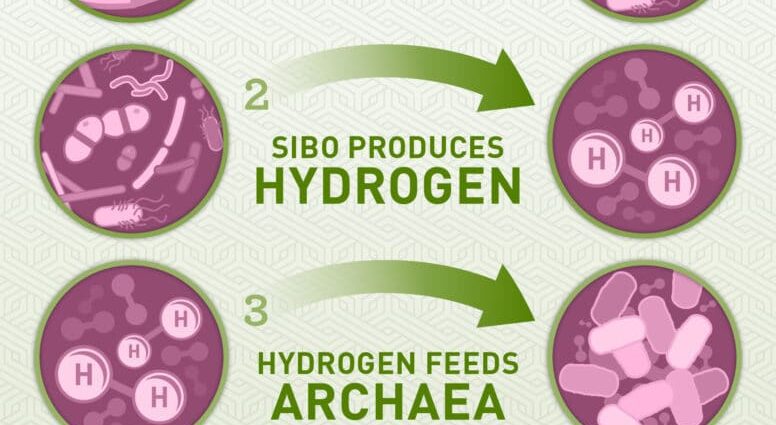Contents
SIBO: symptoms and treatments of this infection?
The term SIBO stands for “small intestinal bacterial overgrowth” and refers to a bacterial overgrowth of the small intestine, which is characterized by an excessive number of bacteria in this part of the intestine and malabsorption. The most common clinical manifestations are diarrhea, gas and symptoms of malabsorption. The factors predisposing to bacterial overgrowth are either anatomical (diverticulosis, blind loop, etc.) or functional (disturbances in intestinal motility, absence of gastric acid secretion). Treatment consists of a high-fat, low-carbohydrate diet, management of deficiencies, broad-spectrum antibiotic therapy, and elimination of contributing factors to prevent recurrence.
What is SIBO?
The term SIBO stands for “small intestinal bacterial overgrowth” or bacterial overgrowth of the small intestine. It is characterized by an excessive number of bacteria in the small intestine (> 105 / ml) which can cause malabsorption disorders, i.e. insufficient absorption of food substances.
What are the causes of SIBO?
Under normal conditions, the proximal part of the small intestine contains less than 105 bacteria / ml, mainly aerobic Gram-positive bacteria. This low bacterial concentration is maintained by:
- the effect of normal intestinal contractions (or peristalsis);
- normal gastric acid secretion;
- mucus;
- secretory immunoglobulins A;
- a functioning ileocecal valve.
In case of bacterial overgrowth, an excess of bacteria,> 105 / ml, is found in the proximal intestine. This can be linked to:
- abnormalities or anatomical changes in the stomach and / or small intestine (diverticulosis of the small intestine, surgical blind loops, post-gastrectomy conditions, strictures or partial obstructions) that promote slowing of intestinal contents, leading to bacterial overgrowth;
- motor disorders of the digestive tract associated with diabetic neuropathy, scleroderma, amyloidosis, hypothyroidism or idiopathic intestinal pseudo-obstruction which may also decrease bacterial evacuation;
- an absence of gastric acid secretion (achlorhydria), which may be of drug or surgical origin.
What are the symptoms of SIBO?
The most common bacterial species for bacterial overgrowth in the small intestine include:
- Streptococcus sp ;
- Bacteroides sp ;
- Escherichia coli ;
- Staphylococcus sp ;
- Klebsiella sp ;
- and Lactobacillus.
These excess bacteria reduce the absorption capacity of intestinal cells and consume nutrients, including carbohydrates and vitamin B12, which can result in carbohydrate malabsorption and nutrient and vitamin deficiency. Moreover, these bacteria also act on bile salts by altering them, they prevent the formation of micelles which leads to malabsorption of lipids. The severe bacterial overgrowth finally leads to lesions of the intestinal mucosa.
Many patients have no symptoms. In addition to initial weight loss or deficiencies in nutrients and fat-soluble vitamins (especially vitamins A and D), the most common symptoms include:
- abdominal discomfort;
- more or less severe diarrhea;
- steatorrhea, that is, an abnormally high amount of lipids in the stool, resulting from malabsorption of lipids and damage to the mucous membranes;
- bloating;
- excessive gas, caused by gases produced by the fermentation of carbohydrates.
How to treat SIBO?
Antibiotic therapy must be put in place, not to eradicate the bacterial flora but to modify it in order to obtain an improvement in symptoms. Due to the polymicrobial nature of the intestinal flora, broad spectrum antibiotics are necessary to cover all aerobic and anaerobic bacteria.
The treatment of SIBO is thus based on taking, for 10 to 14 days, orally, one or two of the following antibiotics:
- Amoxicillin / clavulanic acid 500 mg 3 times / day;
- Cephalexin 250 mg 4 times / day;
- Trimethoprim / sulfamethoxazole 160 mg / 800 mg twice / day;
- Metronidazole 250 to 500 mg 3 or 4 times / day;
- Rifaximin 550 mg 3 times a day.
This broad-spectrum antibiotic treatment can be cyclical or even modified, if the symptoms tend to reappear.
At the same time, the factors favoring bacterial overgrowth (anatomical and functional abnormalities) must be eliminated and a modification of the diet is recommended. Indeed, the excess bacteria mainly metabolize carbohydrates in the intestinal lumen rather than lipids, a diet high in fat and low in fiber and carbohydrate – lactose free – is recommended. Vitamin deficiencies, especially vitamin B12, must also be corrected.










